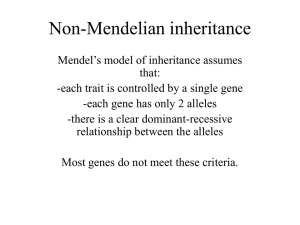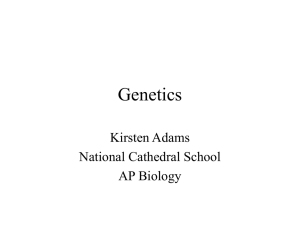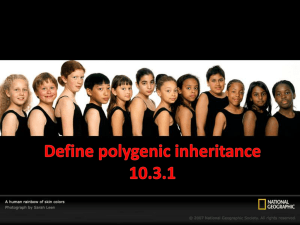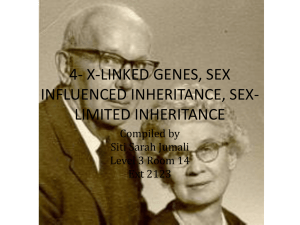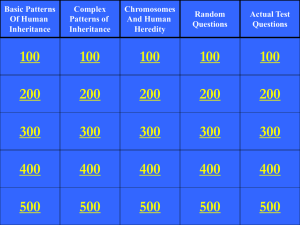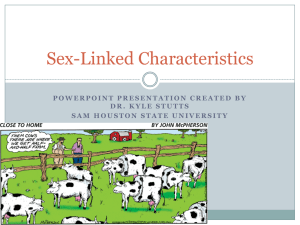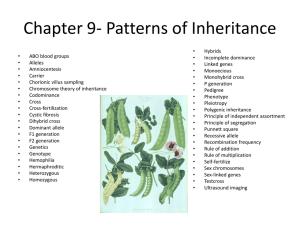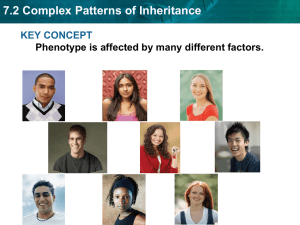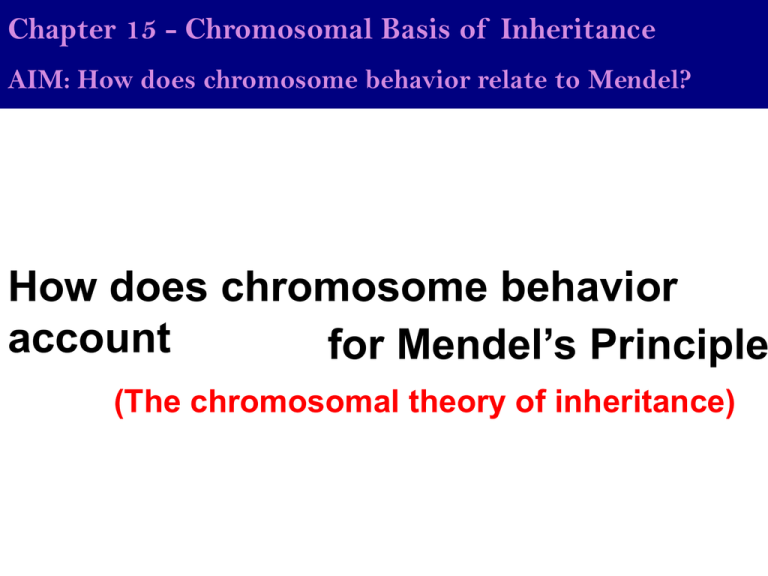
Chapter 15 - Chromosomal Basis of Inheritance
AIM: How does chromosome behavior relate to Mendel?
How does chromosome behavior
account
for Mendel’s Principle
(The chromosomal theory of inheritance)
The chromosomal theory of inheritance:
The chromosomal theory of inheritance:
The chromosomal theory of inheritance:
The Chromosome Theory of Inheritance: genes (allele pairs) are on chromosomes and
homologous chromosomes segregate during meiosis (principle of segregation) and reunite during
fertilization. If allele pairs are on different chromosomes they will sort independently (principle of
independent assortment) due to independent orientation of the tetrads at metaphase I. If the allele
pairs are on the same chromosome, they will sort dependently and travel together into the
gametes.
Chapter 15 - Chromosomal Basis of Inheritance
AIM: How does chromosome behavior relate to Mendel?
Draw out meiosis and indicate how this process accounts
for the laws of segregation and independent assortment.
Meiosis accounts for
the laws of
segregation and
independent
assortment.
Make sure you can quickly draw
this and explain how the laws of
segregation and independent
assortment are described by
meiosis and specifically where in
meiosis.
The two alleles of
each gene separate.
Alleles of genes on nonhomologous chomosomes
assort independently
during gamete formation.
Chapter 15 - Chromosomal Basis of Inheritance
AIM: How does chromosome behavior relate to Mendel?
What have we been ignoring thus
far during dependent assortment?
Crossing-Over
You perform an experiment where
you cross a double heterozygous
plant with purple flower and long
pollen with another of the same
genotype.
P = purple flower
L = long pollen
p = red flower
l = round pollen
PpLl x PpLl
1. Determine the expected phenotypic ratio if the allele pairs were on
different chromosomes – independent assortment.
This is identical to Mendel’s classic F1 dihybrid cross resulting in a
9 purple,long : 3 purple, round : 3 red, long : 1 red, round
2. Determine the expected phenotypic ratio if the allele pairs were linked (P
is linked to L).
Possible gametes: PL or pl for both
Making a Punnett square or just putting together the possible fertilization
events gives you the following offspring: PPLL, PpLl, PpLl, ppll or a
3 purple,long : 1 red, round phenotypic ratio
Take a look at the actual offspring:
Neither prediction fits this observation…
How can you account for this observation?
Come up with a model for how this can occur.
If the alleles did sort independently, you would
expect to see the 9:3:3:1 phenotypic ratio.
Therefore they are likely sorting dependently,
but how do we account for the purple-round and
red-long offspring?...
CROSSING OVER
Parental Type Gametes
Synapsis during
Prophase I
P
L
p
l
P
l
p
L
P L
p l
Recombinant Gametes
If the alleles did sort independently, you would
expect to see the 9:3:3:1 phenotypic ratio.
Therefore they are likely sorting dependently,
but how do we account for the purple-round and
red-long offspring?...
CROSSING OVER
Parental Type Gametes
P
L
p
l
P
l
p
L
P L
p l
Recombinant Gametes
Predict the resulting gametes…
If the alleles did sort independently, you would
expect to see the 9:3:3:1 phenotypic ratio.
Therefore they are likely sorting dependently,
but how do we account for the purple-round and
red-long offspring?...
CROSSING OVER
Parental Type Gametes
P
L
p
l
P
l
p
L
P L
p l
Recombinant Gametes
You get the same gametes as if it were
independent assortment because of crossing
over, but what is going to be different?
If the alleles did sort independently, you would
expect to see the 9:3:3:1 phenotypic ratio.
Therefore they are likely sorting dependently,
but how do we account for the purple-round and
red-long offspring?...
CROSSING OVER
Parental Type Gametes
P
L
p
l
P
l
p
L
P L
p l
Recombinant Gametes
They are not made in a 1:1:1:1 ratio since
crossing over doesn’t always occur between the
allele pairs…
The majority will be parental type…
Which gametes need to fuse in order to
get the recombinant offspring?
Parental Type Gametes
P
L
p
l
P
l
p
L
P L
p l
Recombinant Gametes
Whatever the PL gamete fertilizes, the outcome is
the same… the purple, long phenotype.
What do you think determines
the number of recombinant
offspring?
Parental Type Gametes
P
L
p
l
P
l
p
L
P L
p l
Recombinant Gametes
The number of gametes with the
recombinant chromosome of course…
What do you think determines how
often crossing over occurs between
the P/p and L/l genes?
Parental Type Gametes
P
L
p
l
P
l
p
L
P L
p l
Recombinant Gametes
The number of crossing over events between
the allele pairs is directly related to how far
apart the allele pairs are on the chromosome…
The further apart they are, the more likely it is
that crossing over will occur BETWEEN them.
Parental Type Gametes
P
L
p
l
P
l
p
L
P L
p l
Recombinant Gametes
Therefore, the more recombinant offspring you
further
get, the_________________
apart the allele
pairs are.
Chapter 15 - Chromosomal Basis of Inheritance
AIM: How does chromosome behavior relate to Mendel?
If I have three or more pairs of alleles, I want to
know where they are on a chromosome relative to
each other. How can we do that?
Thomas Hunt (T. H.) Morgan
Drosophila melanogaster
(The modern day pea plant)
The Fly Room
Fruit fly experiments
demonstrating the role of
crossing-over in inheritance
and recombination frequency
Predict the offspring phenotypic
ratio for dependent assortment
where G is linked to L.
Characteristics: Body Color
Traits: G = gray body (dominant)
g = black body
Wing shape
L = long wings (dominant)
l = vestigial,short wings
GgLl (wild type female) x ggll (male)
Gametes: GL, gl
gl
Offspring: GgLl or ggll (both are parental type)
1 Gray, long wings : 1 black, vestigial/short wings
Fig. 9.19C
Fruit fly experiments
demonstrating the role of
crossing-over in inheritance
and recombination frequency
1 Gray, long wings : 1 black, short wings
IT DOESN’T MATCH…WHY?
CROSSING OVER…
Draw the possible gametes in each parent (show chromosomes).
Indicate the parental-type and recombinant chromosomes.
Fig. 9.19C
Fruit fly experiments
demonstrating the role of
crossing-over in inheritance
and recombination frequency
CROSSING OVER…
Fig. 9.19C
Fruit fly experiments
demonstrating the role of
crossing-over in inheritance
and recombination frequency
What do the number of recombinant phenotypes
relative to the total offspring tell you?
1. They tell you the number of times crossing over occurred
between the G/g and L/l allele pairs in the FEMALE ONLY…why?
The male was chosen to be double homozygous recessive on purpose
so that crossing over does not matter because the same gametes form
either way. Thus, from this experiment one can determine the frequency
of crossing over in a SINGLE INDIVIDUAL.
Fruit fly experiments
demonstrating the role of
crossing-over in inheritance
and recombination frequency
That’s great, but who cares…what is this useful for?
1. Remember, the further apart the allele pairs are, the more
recombinant offspring you should get.
2. Therefore, one can do this with another pair of alleles like G/g
and P/p. If the result is fewer recombinants than with G and L, P
is closer to G…
3. You can determine where allele pairs are relative to each other
on a chromosome = chromosome mapping (linkage mapping)!!
Fruit fly experiments
demonstrating the role of
crossing-over in inheritance
and recombination frequency
The recombinant frequency can be determined by taking the
number of recombinants and dividing by the total offspring and
multiplying by 100.
Fig. 9.19C
Fruit fly experiments
demonstrating the role of
crossing-over in inheritance
and recombination frequency
Fig. 9.19C
Fruit fly (Drosophila) nomenclature
1. Genes are typically named after the mutant (non-wild type) allele. In this
case black (b) and vestigial (vg).
2. The wild type is then indicated with a “+”. Therefore grey would be b+
and long wings would be vg+.
Fruit fly (Drosophila) nomenclature
SUMMARY:
Grey (wild type; wt)
b+
Black (mutant; mut)
b
Long Wings (wt)
vg+
Vestigial Wings (mut)
vg
Fruit fly (Drosophila) nomenclature
This is the same figure as shown
previously just using Drosophila
gene nomenclature.
Independent Assortment
9:3:3:1 phenotypic ratio
Independent Assortment
9:3:3:1 phenotypic ratio
Linked Genes (no recombination)
Independent Assortment
9:3:3:1 phenotypic ratio
Linked Genes (WITH recombination)
Independent Assortment
9:3:3:1 phenotypic ratio
Linked Genes (WITH recombination)
Independent Assortment
9:3:3:1 phenotypic ratio
Linked Genes (WITH recombination)
Chapter 15 - Chromosomal Basis of Inheritance
AIM: How does chromosome behavior relate to Mendel?
How can we use recombination frequency to determine the
position of genes on a chromosome (gene mapping)?
You have determined the frequency between
G/g and L/l (17%). There is a third gene on the
same chromosome (E/e). How can you
determine the frequency between G and E/e?
By doing this testcross:
GgEe x ggee
Chapter 15 - Chromosomal Basis of Inheritance
AIM: How does chromosome behavior relate to Mendel?
How can we use recombination frequency to determine the
position of genes on a chromosome (gene mapping)?
Let’s say you determine the recombinant
frequency to be 9%. What does that tell
you?
It tells you that recombination occurred
less frequently between G and E and
therefore they are closer together than G
and L.
Let’s try to map this on a chromosome…
(convince yourself that it is not possible yet)
G
9%
E
L
17%
or
E
9%
G
L
Chapter 15 - Chromosomal Basis of Inheritance
AIM: How does chromosome behavior relate to Mendel?
How can we use recombination frequency to determine the
position of genes on a chromosome (gene mapping)?
What else do we need to do to figure out
the order on the chromosome of G, E and
L?
G
9%
E
L
17%
E
9%
G
L
We need to figure out the recombinant freq
between L and E…is it ~8% or ~26%:
LlEe x llee
Chapter 15 - Chromosomal Basis of Inheritance
AIM: How does chromosome behavior relate to Mendel?
How can we use recombination frequency to determine the
position of genes on a chromosome (gene mapping)?
You determine the recombinant offspring
frequency to be 9.5%. Now can you map
the genes?
Chapter 15 - Chromosomal Basis of Inheritance
AIM: How does chromosome behavior relate to Mendel?
How can we use recombination frequency to determine the
position of genes on a chromosome (gene mapping)?
e
This is the only possible combination that fits the data (or
l,e,g – e must be between them)…
Chapter 15 - Chromosomal Basis of Inheritance
AIM: How does chromosome behavior relate to Mendel?
Chapter 15 - Chromosomal Basis of Inheritance
AIM: How does chromosome behavior relate to Mendel?
A geneticist wants to map the position of three dominant/recessive
allele pairs (A/a, B/b, and F/f) relative to each other in D. melanogaster
(fruit flies). For simplicity let’s say all the dominant alleles are on the
same chromosome. Where should she begin?
1. Do AaBb x aabb and look for recombinant phenotypes to determine
the frequency of crossing-over
Her cross generates 1000 offspring of which 200 are recombinant. What
is the recombination frequency?
200/1000 * 100 = 20%
What should she do next?
Chapter 15 - Chromosomal Basis of Inheritance
AIM: How does chromosome behavior relate to Mendel?
A geneticist wants to map the position of three dominant/recessive
allele pairs (A/a, B/b, and F/f) relative to each other in D. melanogaster
(fruit flies). For simplicity let’s say all the dominant alleles are on the
same chromosome. Where should she begin?
2. Do AaFf x aaff and BbFf x bbff
Find recombinant phenotypes to determine the frequency of crossing-over
The AaFf cross results in a 7% recombinant frequency
The BbFf cross results in a 28% recombinant frequency
The AaBb cross resulted in a 20% recombinant frequency
Map the genes on the chromosome:
B
A
F
Chapter 15 - Chromosomal Basis of Inheritance
AIM: Sex-linked gene inheritance.
Sex-Linked Gene Inheritance
Chapter 15 - Chromosomal Basis of Inheritance
AIM: Sex-linked gene inheritance.
Sex determination in humans obviously also uses the
XY system where the Y chromosome determine if the
individual is male. Do all sexually reproducing animals
work the same…?
Chapter 15 - Chromosomal Basis of Inheritance
AIM: Sex-linked gene inheritance.
Turns out the answer is no…
Your book has a very brief explanation of these systems (Figure 15.9).
Chapter 15 - Chromosomal Basis of Inheritance
AIM: Sex-linked gene inheritance.
Eye color is determined by a dominant/recessive single
gene locus on the X chromosome.
R = red-eye allele
r = white-eye allele
Q. Determine the possible offspring from a cross
between a homozygous dominant red eye female and a
white eye male.
Chapter
15are
- Chromosomal
of Inheritance
AIM: What
sex-linked genesBasis
and what
makes them different
fromSex-linked
autosomal genes?
AIM:
gene inheritance.
Notice that now because we have two variables to
follow…allele pair and sex chromosome…we no
longer just write the allele pair. Therefore the female
in this case is homozygous dominant RR, each on an
X chromosome = XRXR), while the white eye male is
just r on one X (Xr) as the Y chromosome does not
have the same loci as X (X and Y are not
homologous) = XrY. Continue as normal- possible
gametes, fertilize, etc…
Chapter
15are
- Chromosomal
of Inheritance
AIM: What
sex-linked genesBasis
and what
makes them different
fromSex-linked
autosomal genes?
AIM:
gene inheritance.
There are two possible offspring:
Red eye females
Red eye males
Chapter
15are
- Chromosomal
of Inheritance
AIM: What
sex-linked genesBasis
and what
makes them different
fromSex-linked
autosomal genes?
AIM:
gene inheritance.
Q. Determine the possible offspring from cross between
a red eye female heterozygous for the gene locus and a
red eye male.
Chapter
15are
- Chromosomal
of Inheritance
AIM: What
sex-linked genesBasis
and what
makes them different
fromSex-linked
autosomal genes?
AIM:
gene inheritance.
Chapter
15are
- Chromosomal
of Inheritance
AIM: What
sex-linked genesBasis
and what
makes them different
fromSex-linked
autosomal genes?
AIM:
gene inheritance.
50% male, half of which
have red eyes and half
with white.
50% red eye females,
half heterozygous and
half homozygous
dominant
Chapter
15are
- Chromosomal
of Inheritance
AIM: What
sex-linked genesBasis
and what
makes them different
fromSex-linked
autosomal genes?
AIM:
gene inheritance.
Q. Determine the possible offspring from cross between
a red eye female heterozygous for the gene locus and a
white eye male.
Chapter
15are
- Chromosomal
of Inheritance
AIM: What
sex-linked genesBasis
and what
makes them different
fromSex-linked
autosomal genes?
AIM:
gene inheritance.
Chapter
15are
- Chromosomal
of Inheritance
AIM: What
sex-linked genesBasis
and what
makes them different
fromSex-linked
autosomal genes?
AIM:
gene inheritance.
Chapter
15are
- Chromosomal
of Inheritance
AIM: What
sex-linked genesBasis
and what
makes them different
fromSex-linked
autosomal genes?
AIM:
gene inheritance.
Hemophilia
1. A group of hereditary disorders where the blood does not
clot (or coagulate) efficiently.
2. Typically caused by mutations in genes that code for
clotting factors (proteins involved in blood clotting).
3. Incidence is 1 in 10,000 males approximately
4. Severity can vary
5. No cure, but how would you treat it?
- Give regular infusions (injections) of the protein the
person is deficient in (prophylaxis = treating before the
problem)
Chapter
15are
- Chromosomal
of Inheritance
AIM: What
sex-linked genesBasis
and what
makes them different
fromSex-linked
autosomal genes?
AIM:
gene inheritance.
Hemophilia in humans is due to a recessive X-chromosome
mutation. What will be the results of mating between a normal
(non-carrier) female and a hemophiliac male?
XHXH x XhY
XH
XH
Xh
XHXh
XHXh
Y
XH Y
XH Y
50% chance of female carrier, 0% chance of male hemophiliac
Chapter
15are
- Chromosomal
of Inheritance
AIM: What
sex-linked genesBasis
and what
makes them different
fromSex-linked
autosomal genes?
AIM:
gene inheritance.
Hemophilia in the Royal
Families of Europe
A half-filled shape in a pedigree
implies carrier
Chapter
15are
- Chromosomal
of Inheritance
AIM: What
sex-linked genesBasis
and what
makes them different
fromSex-linked
autosomal genes?
AIM:
gene inheritance.
A red-eyed female Drosophila of unknown genotype was crossed
with a white-eyed male fly. Half of the male and half of the female
offspring were red-eyed, and half of the male and half of the
female offspring were white-eyed. What was the genotype of the
female fly?
XrY x ??
25% XRY
r
R
X
X
R
?
25% X X
25% XrY
RXr
rXr
r
X
X
X
25% XrXr
Y
XrY
XRY
XRXr
Chapter
15are
- Chromosomal
of Inheritance
AIM: What
sex-linked genesBasis
and what
makes them different
fromSex-linked
autosomal genes?
AIM:
gene inheritance.
Why do recessive sex-linked disorders affect mostly males?
Because males only have one
copy of the X chromosome
and therefore only need to
inherit one disease allele.
They cannot be carriers.
Ex) Color Blindness
- Can be caused by mutations in many
different genes typically affecting
proteins in the cone cells (color sensing
cells) of the eye.
- Deuteranomaly – most common type
(affects 5% of males) – sex linked on X
chromosome
Red-green color blind test
Chapter
15are
- Chromosomal
of Inheritance
AIM: What
sex-linked genesBasis
and what
makes them different
fromSex-linked
autosomal genes?
AIM:
gene inheritance.
Why do recessive sex-linked disorders affect mostly males?
Because males only have one
copy of the X chromosome
and therefore only need to
inherit one disease allele.
They cannot be carriers.
Ex) Color Blindness
- Why might the frequency of this allele
be this high (5%)? - remember that sickle
cell allele is 4%
It is hypothesize that there might be an
advantage to being color blind as these
individuals appear to be better at spotting
camouflaged objects…
Red-green color blind test
Chapter
15are
- Chromosomal
of Inheritance
AIM: What
sex-linked genesBasis
and what
makes them different
fromSex-linked
autosomal genes?
AIM:
gene inheritance.
Color of the rainbow as viewed by a normal
person
Color of the rainbow as viewed by a person
with color-blindness (Deuteranomaly)
Chapter
15are
- Chromosomal
of Inheritance
AIM: What
sex-linked genesBasis
and what
makes them different
fromSex-linked
autosomal genes?
AIM:
gene inheritance.
Chapter 15 - Chromosomal Basis of Inheritance
AIM: Sex-linked gene inheritance.
Morgan’s experiment involving
sex-linkage reveled that genes
were on chromosomes.
Q. A cross was done between a wt redeyed female and a true breed mutant
white-eyed male. What offspring do you
expect in terms of phenotype?
Chapter 15 - Chromosomal Basis of Inheritance
AIM: Sex-linked gene inheritance.
Morgan’s experiment involving
sex-linkage reveled that genes
were on chromosomes.
A. All red-eyed offspring as usual.
Q. He then crossed the F1 generation.
What do you expect in terms of
phenotype?
Chapter 15 - Chromosomal Basis of Inheritance
AIM: Sex-linked gene inheritance.
Morgan’s experiment involving
sex-linkage reveled that genes
were on chromosomes.
A. The standard 3 red : 1 white is
observed, but look more closely…what
do you notice?
Females
All red-eyes
Males
50% red, 50% white
How did Morgan explain this?
Sex-linked genes (the gene for eye-color is on the X chromosome)
Chapter 15 - Chromosomal Basis of Inheritance
AIM: Sex-linked gene inheritance.
Morgan’s experiment involving
sex-linkage reveled that genes
were on chromosomes.
In order to understand the importance of this
experiment, it must be put in the proper context:
1866 - Mendel’s work published never
gaining popularity.
1875 - Mitosis figured out
1890 - Meiosis figured out
1900 – Mendel’s work rediscovered
1902 – Chromosomal Theory of
Inheritance gains popularity
1910 – Morgan and co-workers
performed the experiment shown to the
right giving us the first solid piece of
evidence that genes are on
chromosomes.
Chapter 15 - Chromosomal Basis of Inheritance
AIM: Sex-linked gene inheritance.
Morgan’s experiment involving
sex-linkage reveled that genes
were on chromosomes.
How does this experiment indicate that genes
are on chromosomes?
1. Morgan and others already figured
out how sex determination worked in
terms of chromosomes (XY – male,
XX – female) in fruit flies.
2. The simplest way to account for the
pattern in the F2 generation, which is
clearly related to the sex of the fly, is
to predict that the gene for eye color
is on the X chromosome.
Chapter 15 - Chromosomal Basis of Inheritance
AIM: Sex-linked gene inheritance.
We now knew with a good level of
certainty that genes, whatever they are,
travel on chromosomes...
Thomas Hunt Morgan
received the Nobel
Prize in 1933 for his
work done at Columbia
University in his
famous fly room.

